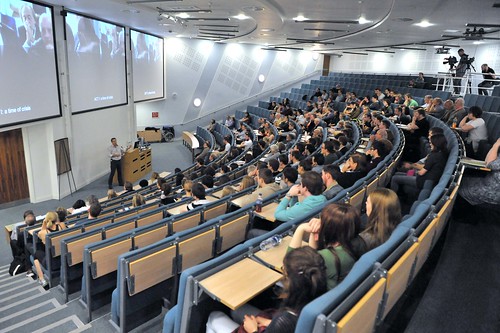
"Prof Iain Stewart in Allam Lecture Theat" (CC BY-ND 2.0) by Science and Engineering - University of Hull
Despite all the studies and articles about the inefficiency of lecturing we seem to be addicted to the habit. I freely admit that I don't always practice what I preach but the format and location of most conferences make the traditional lecture almost unavoidable. It's rather amusing how many conferences I've attended on subjects like innovative pedagogy or future learning spaces that are based almost exclusively around lectures and the dreaded panel debates. Indeed I've listened to extremely boring lectures about innovative pedagogy.
So if we have to continue giving presentations, how can we lighten them up just a bit? The crucial success factors are of course enthusiasm for your subject and the ability to show an interest in the audience (eye contact, smiles, rhetorical questions etc). Talk to the audience, not at them. However probably most discussed feature of presentations is the question of whether or not to use slideshows. I'm always very wary of speakers who go "unplugged" and present without visual aids. Although there are a few genuine orators who can keep an audience's attention simply by the power of their narrative, the vast majority who try this tactic fail. Without the visual support the presentation becomes aimless and there are seldom any clues on how long it is going to last, what the objectives are or what the common theme is. It's all too easy to lose your audience..
I think we need to consider the choreography of a presentation. Even if it is largely a monologue it can vary in pace, deliver styles and types of interaction. Whether it's PowerPoint or Prezi doesn't really matter much in my opinion but the important factor is how they support your message. Far too many speakers still overload their slides with far too much text in an honest desire to provide as much information/value as possible but forgetting that there is a limit to how much an audience can absorb. Cognitive overload is a common problem and can be resolved by not talking when people need to read and not showing text when people are expected to listen. Use the slides to reinforce the structure of your presentation through keywords and images and provide the details orally. If you do have important information on a slide why not pause to let everyone read it before providing the details? Ask the audience to discuss the issue in pairs for a minute or so or simply ask a question for short silent reflection.
An article in Inside Higher Ed, A 50% Content / Discussion Formula for Academic Presentations presents a possible solution to turning presentations into discussions; cutting the input quota of your presentation to 50% and using the rest of the time for discussion. Very seldom is there much time for discussion even if that is what we value most at a conference.
Certainly, this 50 percent formula certainly is not the norm for academic presentations. Most academic presentations leave little time for discussion. Content takes up most of the time. Most often, the presenter is rushing to get through all the content that she has planned to present. Sometimes discussion between the presenter and the audience does happen during the presentation, but that is rare. The larger the audience the less likely there is to be an integrated presentation / discussion format.
The author points out quite rightly that when there is time for questions from the audience it can often be counter-productive. Most questions are not even questions and some participants even take the opportunity to start their own alternative lecture. Question sessions generally fail because they can only accommodate a handful of participants at best, normally those who are most vocal. The majority are still silent.
One way around this could be to finish early and then pose 1-3 questions arising from your talk. Ask the audience to discuss in small groups and post their ideas and questions on a common document (like Google Docs) or workspace (like Padlet). For the last five minutes you can project the results on the screen, comment on some of them and promise to answer the rest later in the day. That way everyone gets to discuss your ideas, ask questions and provide new insights without the awkwardness of the usual plenum questions session.
By paying more attention to the choreography of a lecture we may be able to get more out of it.
No comments:
Post a Comment